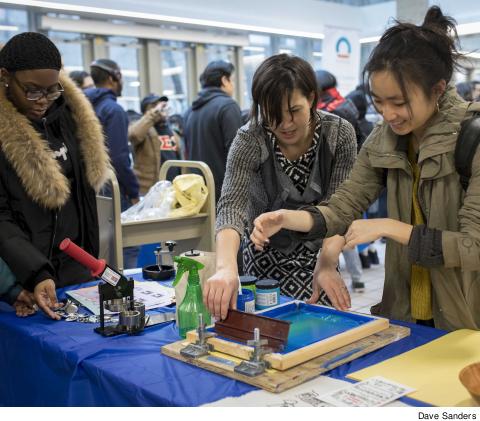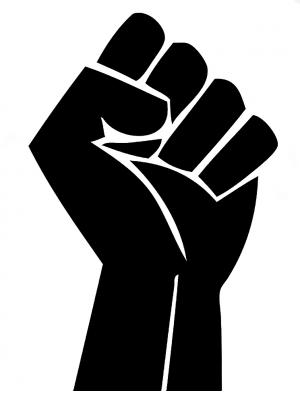PSC should get creative with protests.
 |
In September 2019, I spent two weekends leading up to the Global Climate Strike in a small park in Brooklyn’s Gowanus neighborhood making art with local families, student organizers, artists and environmental activists. I shared a table with members of Mobile Print Power, a multigenerational printmaking collective, who cocreate artwork for social justice campaigns. During the art-builds, I talked to hundreds of people about the climate movement and taught young people how to screen print – including students from the interdisciplinary course I teach at City Tech.
 |
INSPIRED BY THE CITY
I walked home after each art-build around dusk, exhausted, jubilant and covered in paint. The day before the Climate Strike, I lugged my screen printing supplies to campus and tabled with NYPIRG organizers during student club hour. We talked to students about climate justice while making buttons and printing posters using an image designed by a City Tech communications design student.
On the day of the Climate Strike, as I marched through the streets of Manhattan amidst a sea of strangers, I kept spotting familiar designs from the Gowanus art-builds. Later that afternoon, I ran into our campus NYPIRG representative and striking City Tech students wielding the posters we’d made together. It is hard to describe how it feels to spot a stranger on the train or at a rally carrying a symbol from a movement you’re part of. Symbols have the capacity to transform a space or make us feel safe. From Black Power fists to the “sabo-tabby” of the Industrial Workers of the World (IWW) to the egg-yolk-yellow anti-nuclear movement’s Smiling Sun, symbols function as cultural signifiers, play a role in how a struggle is understood by the public and contribute to the production of political power.
 |
THE ART OF LABOR
Some of the most creative social justice campaigns in history have come from labor and student movements. In the 1960s, Students for a Democratic Society members created now-iconic graphics for antiwar demonstrations and in support of the Black Power Movement. In May 1968, students occupied École des Beaux-Arts and formed Atelier Populaire (popular workshop) to create artwork in support of labor and student rights during the French wildcat strikes.
The IWW, for example, was the first activist group to use political stickers – members carried little red songbooks full of labor anthems, and they engaged in political theater. In 1913, when striking Paterson silk factory workers, with support from IWW leaders, staged a ‘strike pageant’ at (the original) Madison Square Garden, more than 150,000 spectators attended the pageant, which included a reenacted picket-line, funeral, and “march” up Fifth Avenue. While the pageant didn’t end the strike, it raised public awareness about dangerous conditions for textile workers and paved the way for future labor laws.
The process of making art is a generative and integral part of organizing. When I’m making art with students on campus, we talk about the issues most affecting them – like the CUNY funding crisis – in an informal, non-hierarchical environment. Last February, I made posters with students in advance of Higher Education Action Day and was surprised to discover how many students don’t know about the “TAP gap,” or why support services and library hours are cut, or why tuition keeps creeping up. It is important to share our experiences and collectively develop creative tactics (and symbols) we can use to advocate for funding.
A WAY TO PARTICIPATE
At CUNY, art-builds can provide a mode of political participation for members of our community – students and faculty of color, precarious workers, undocumented students and those with disabilities – who are either unable to engage in direct action campaigns or can only do so at great risk. In the case of the current funding crisis at CUNY, making art might also help us counteract some of the feelings of disempowerment, isolation and anxiety that prolonged austerity creates.
CUNY needs its own popular workshop to unite the labor struggle and the student struggle, and to energize anyone who does not feel connected to (or does not have the emotional energy for) modes of organizing that replicate institutional hierarchies and power dynamics.
If the way forward for CUNY is to create broad coalitions with other social justice organizations, to encourage broader participation and mobilization on our campuses and advance a public narrative that everyone has a right to a quality education, then we should make art together and embrace opportunities for non-hierarchical interaction. To gain political traction and build a movement, CUNY students and PSC activists need to get creative; we might surprise administrators, lawmakers and even ourselves.
Nora Almeida is an assistant professor in the library department at City Tech.

